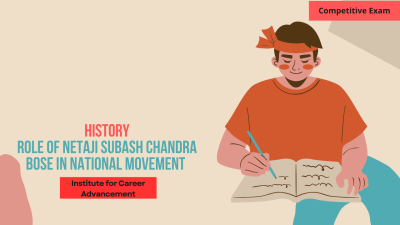Course description
This course delves into the life, ideology, and pivotal role of Netaji Subhas Chandra Bose in India's struggle for independence. It covers his contributions as a leader, his radical approach to achieving freedom, and the formation and operations of the Indian National Army (INA). The course will explore Bose’s political philosophy, his relationships with other leaders, his international alliances, and his legacy in the context of India’s freedom struggle.
Key Topics:
1. Introduction to Subhas Chandra Bose’s Early Life and Education:
Explore the early life, family background, and education of Subhas Chandra Bose.
His initial exposure to Western education, and the influence of his experiences on his nationalist outlook.
His early involvement in nationalist politics and his interactions with key leaders of the Indian National Congress (INC).
2. Bose’s Ideological Shift and Break from the Congress:
Examine Bose’s early involvement in the Indian National Congress, his alignment with Mahatma Gandhi’s ideals, and later disagreements with Gandhian methods.
Discuss his belief in complete independence and his frustration with the Congress leadership's more moderate stance.
His decision to break away and form his own vision for India’s future.
3. Bose and the Rise of Radical Nationalism:
Study Bose’s radical nationalism, emphasizing his commitment to using force and direct action for achieving India’s independence.
His belief in the importance of militarization and self-reliance to gain freedom.
Analysis of his book “The Indian Struggle”, outlining his political ideas and vision for India’s future.
4. Subhas Chandra Bose and the Indian National Congress:
Explore Bose’s tenure as President of the Indian National Congress in the late 1930s and early 1940s.
His leadership and the division within the Congress, especially his differences with Gandhi and the Congress Working Committee.
His resignation from the presidency and the formation of the Forward Bloc.
5. Bose’s International Strategy and the Quest for Global Support:
Investigate Bose’s diplomatic efforts to seek international support for India’s independence.
His interactions with Germany and Japan during World War II, and his pursuit of military and financial aid for the Indian freedom struggle.
The significance of Bose’s alliances with Axis powers during the war and his efforts to form an international front against British colonial rule.
6. Formation and Role of the Indian National Army (INA):
Study the creation of the Indian National Army (INA) under Bose’s leadership, and its operations in Southeast Asia.
The INA’s military campaigns in Burma and other territories, and its role in challenging British authority in India.
The INA’s impact on Indian morale and its contribution to the post-war nationalist movement.
7. Bose’s Leadership and the INA’s Struggle:
Analyze the battles and campaigns led by the INA, especially their role in the Battle of Imphal and other key encounters during World War II.
The INA's symbolic and practical significance in India’s fight for independence.
The challenges faced by Bose in organizing and leading a multinational army in foreign lands.
8. Subhas Chandra Bose’s Disappearance and Controversy:
Discuss the mysterious circumstances surrounding Netaji’s disappearance in 1945 and the debates about his death.
The various theories and speculations about Bose’s fate, and the impact this had on his legacy.
The continuing influence of his ideology and leadership on future generations of nationalists.
9. Legacy of Netaji Subhas Chandra Bose:
Reflect on Bose’s enduring legacy as a national hero.
How his contributions influenced post-independence India, especially in terms of defense, nationalism, and the vision of a free and strong nation.
The role of Bose’s ideas in shaping India's global stance and independence in the decades following 1947.
এই কোর্সে ভারতের স্বাধীনতা সংগ্রামে নেতাজি সুভাষ চন্দ্র বসুর জীবন, মতাদর্শ এবং গুরুত্বপূর্ণ ভূমিকা নিয়ে আলোচনা করা হয়েছে। এতে একজন নেতা হিসাবে তাঁর অবদান, স্বাধীনতা অর্জনে তাঁর আমূল দৃষ্টিভঙ্গি এবং ইন্ডিয়ান ন্যাশনাল আর্মি (আইএনএ) গঠন ও অপারেশন অন্তর্ভুক্ত রয়েছে। এই কোর্সে বোসের রাজনৈতিক দর্শন, অন্যান্য নেতাদের সঙ্গে তাঁর সম্পর্ক, তাঁর আন্তর্জাতিক জোট এবং ভারতের স্বাধীনতা সংগ্রামের প্রেক্ষাপটে তাঁর উত্তরাধিকার নিয়ে আলোচনা করা হবে।
মূল বিষয়ঃ
1টি। সুভাষ চন্দ্র বসুর প্রাথমিক জীবন ও শিক্ষার পরিচিতিঃ
সুভাষ চন্দ্র বসুর প্রাথমিক জীবন, পারিবারিক পটভূমি এবং শিক্ষা অন্বেষণ করুন।
পাশ্চাত্য শিক্ষার সঙ্গে তাঁর প্রাথমিক পরিচয় এবং তাঁর জাতীয়তাবাদী দৃষ্টিভঙ্গির উপর তাঁর অভিজ্ঞতার প্রভাব।
জাতীয়তাবাদী রাজনীতিতে তাঁর প্রাথমিক সম্পৃক্ততা এবং ভারতীয় জাতীয় কংগ্রেসের (আইএনসি) প্রধান নেতাদের সাথে তাঁর কথোপকথন
2. কংগ্রেস থেকে বোসের মতাদর্শগত পরিবর্তন ও বিচ্ছেদ
ভারতীয় জাতীয় কংগ্রেসে বোসের প্রাথমিক সম্পৃক্ততা, মহাত্মা গান্ধীর আদর্শের সাথে তাঁর সংহতি এবং পরে গান্ধীবাদী পদ্ধতির সাথে মতবিরোধ পরীক্ষা করুন।
সম্পূর্ণ স্বাধীনতার প্রতি তাঁর বিশ্বাস এবং কংগ্রেস নেতৃত্বের আরও মধ্যপন্থী অবস্থান নিয়ে তাঁর হতাশা নিয়ে আলোচনা করুন।
ভেঙে গিয়ে ভারতের ভবিষ্যতের জন্য নিজের দৃষ্টিভঙ্গি গড়ে তোলার তাঁর সিদ্ধান্ত।
3. বোস এবং উগ্র জাতীয়তাবাদের উত্থানঃ
বোসের মৌলবাদী জাতীয়তাবাদ অধ্যয়ন করুন, ভারতের স্বাধীনতা অর্জনের জন্য শক্তি ও সরাসরি পদক্ষেপ গ্রহণের প্রতি তাঁর প্রতিশ্রুতির উপর জোর দিন।
স্বাধীনতা অর্জনের জন্য সামরিকীকরণ এবং আত্মনির্ভরতার গুরুত্বের প্রতি তাঁর বিশ্বাস।
তাঁর বই "দ্য ইন্ডিয়ান স্ট্রাগল"-এর বিশ্লেষণ, যা ভারতের ভবিষ্যতের জন্য তাঁর রাজনৈতিক ধারণা এবং দৃষ্টিভঙ্গির রূপরেখা দেয়।
4. সুভাষ চন্দ্র বসু এবং ভারতীয় জাতীয় কংগ্রেসঃ
1930-এর দশকের শেষের দিকে এবং 1940-এর দশকের গোড়ার দিকে ভারতীয় জাতীয় কংগ্রেসের সভাপতি হিসাবে বোসের কার্যকাল অন্বেষণ করুন।
তাঁর নেতৃত্ব এবং কংগ্রেসের মধ্যে বিভাজন, বিশেষ করে গান্ধী ও কংগ্রেস ওয়ার্কিং কমিটির সঙ্গে তাঁর মতপার্থক্য।
রাষ্ট্রপতি পদ থেকে তাঁর পদত্যাগ এবং ফরওয়ার্ড ব্লক গঠন।
5. বোসের আন্তর্জাতিক কৌশল এবং বৈশ্বিক সমর্থনের জন্য অনুসন্ধানঃ
ভারতের স্বাধীনতার জন্য আন্তর্জাতিক সমর্থন চাওয়ার জন্য বোসের কূটনৈতিক প্রচেষ্টার তদন্ত করুন।
দ্বিতীয় বিশ্বযুদ্ধের সময় জার্মানি ও জাপানের সাথে তাঁর কথোপকথন এবং ভারতীয় স্বাধীনতা সংগ্রামের জন্য সামরিক ও আর্থিক সহায়তার জন্য তাঁর প্রচেষ্টা।
যুদ্ধের সময় অক্ষশক্তির সঙ্গে বোসের জোটের তাৎপর্য এবং ব্রিটিশ ঔপনিবেশিক শাসনের বিরুদ্ধে একটি আন্তর্জাতিক ফ্রন্ট গঠনের জন্য তাঁর প্রচেষ্টা।
6টি। ভারতীয় জাতীয় সেনাবাহিনীর গঠন ও ভূমিকা (আই. এন. এ)
বোসের নেতৃত্বে ইন্ডিয়ান ন্যাশনাল আর্মি (আই. এন. এ) গঠন এবং দক্ষিণ-পূর্ব এশিয়ায় এর কার্যক্রম অধ্যয়ন করুন।
বার্মা এবং অন্যান্য অঞ্চলে আই. এন. এ-এর সামরিক অভিযান এবং ভারতে ব্রিটিশ কর্তৃত্বকে চ্যালেঞ্জ করার ক্ষেত্রে এর ভূমিকা।
ভারতীয় মনোবলের উপর আই. এন. এ-র প্রভাব এবং যুদ্ধোত্তর জাতীয়তাবাদী আন্দোলনে এর অবদান।
7. বোসের নেতৃত্ব এবং আই. এন. এ-র সংগ্রামঃ
আই. এন. এ-র নেতৃত্বে যুদ্ধ ও অভিযান, বিশেষ করে ইম্ফলের যুদ্ধ এবং দ্বিতীয় বিশ্বযুদ্ধের সময় অন্যান্য গুরুত্বপূর্ণ লড়াইয়ে তাদের ভূমিকা বিশ্লেষণ করুন।
ভারতের স্বাধীনতা সংগ্রামে আই. এন. এ-র প্রতীকী ও ব্যবহারিক তাৎপর্য রয়েছে।
বিদেশে একটি বহুজাতিক সেনাবাহিনীকে সংগঠিত ও নেতৃত্ব দেওয়ার ক্ষেত্রে বোসের সম্মুখীন হওয়া চ্যালেঞ্জগুলি।
8. সুভাষ চন্দ্র বসুর অন্তর্ধান ও বিতর্কঃ
1945 সালে নেতাজির নিখোঁজ হওয়ার রহস্যময় পরিস্থিতি এবং তাঁর মৃত্যু নিয়ে বিতর্ক নিয়ে আলোচনা করুন।
বোসের ভাগ্য সম্পর্কে বিভিন্ন তত্ত্ব ও অনুমান এবং তাঁর উত্তরাধিকারের উপর এর প্রভাব।
জাতীয়তাবাদীদের ভবিষ্যৎ প্রজন্মের উপর তাঁর মতাদর্শ ও নেতৃত্বের অব্যাহত প্রভাব।
9টি। নেতাজি সুভাষ চন্দ্র বসুর উত্তরাধিকারঃ
জাতীয় নায়ক হিসেবে বোসের চিরস্থায়ী উত্তরাধিকারের কথা ভাবুন।
তাঁর অবদান কীভাবে স্বাধীনতা-পরবর্তী ভারতকে প্রভাবিত করেছিল, বিশেষত প্রতিরক্ষা, জাতীয়তাবাদ এবং একটি মুক্ত ও শক্তিশালী জাতির দৃষ্টিভঙ্গির ক্ষেত্রে।
1947 সালের পরের দশকগুলিতে ভারতের বৈশ্বিক অবস্থান এবং স্বাধীনতা গঠনে বোসের ধারণাগুলির ভূমিকা।



















